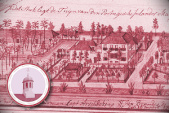IV.6 Buildings, Estates, Houses and Interiors

Information on public and Company buildings such as the Castle complex, VOC warehouses, the town hall, churches, the orphanage and hospital, can be found in the Resolution Books of the Supreme Government along with a number of architectural drawings. One example is the list of building materials for the ‘Portuguese’ church outside the city walls (nowadays ‘Gereja Sion’). Private houses and estates were usually built after drawing up a private contract, often at a notary’s office.
The documentation is not limited to the outward appearance and design of the houses. Thousands of wills of private house owners, big and small, record the inventories of people’s belongings, from the reception room of the house decorated with weapons, to dresses and shirts in the bedroom cupboards to the pots and pans in the kitchens. As the documents show, a variety of Indian, Chinese, Dutch and Javanese textiles and cloths in these private documents, as well as jewellery, artefacts, paintings, writing utensils, books and the appropriate betel boxes. Furniture is also listed in these documents, from bamboo couches to ebony chairs and tables. Asian-European material culture is exceptionally well-documented. This provides a rich topic for specialists.
The material culture of Batavia in all its wealth and variety is an important field of study as many traders and private persons from the length and breadth of the Indonesian Archipelago who came to do business and shop in Batavia. Many ended up imitating the latest fashions from India, China, and Europe.




